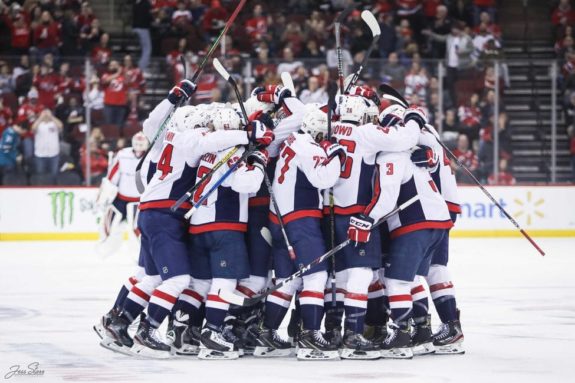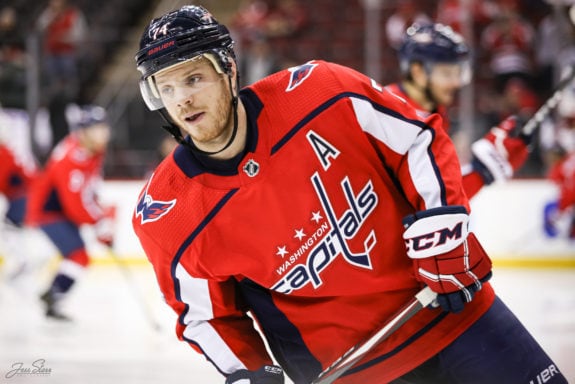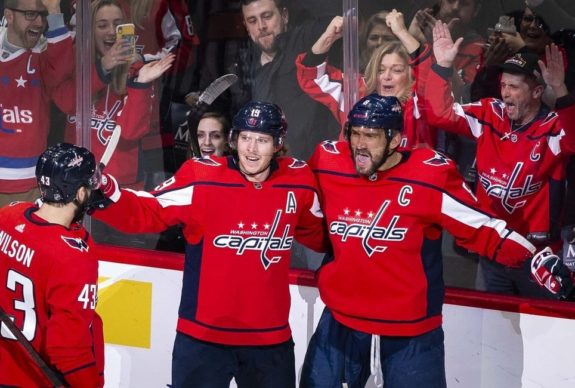The Washington Capitals have gotten off to a hot start during the 2020-21 NHL season despite dealing with some serious setbacks. This hot start of theirs currently has them sitting in first place in the Mass Mutual East Division with a record of 4-0-3. They, along with the Montreal Canadiens, Florida Panthers, and the Dallas Stars, are the only team in the NHL that has not lost a game in regulation.
This solid opening to the season has many Capitals fans thinking back to the glory days of 2018 when Washington raised the Stanley Cup for the first time in franchise history, who many believe was the best one in the franchise’s history. It is tough to argue, but I felt since the team is doing so well at the moment, that it would be fun to compare the roster from the Cup-winning team to their current 2020-21 roster.

The roster I will look at from 2018 will be the one that played in Game 5 of the Stanley Cup Final when they actually won the Stanley Cup. I will compare that roster to the Capitals’ roster from their most recent game before they lost four players due to COVID and also before the Capitals’ injuries piled up. Therefore, it wouldn’t make sense to compare it to the current lineup.
With that way-too-long explanation out of the way, let’s compare.
Viewing the Rosters
2018
Forwards
Ovechkin – Kuznetsov – Wilson
Vrana – Backstrom – Oshie
Burakovsky – Eller – Connolly
Stephenson – Beagle – Smith-Pelly
Defense
Kempny – Carlson
Orlov – Niskanen
Orpik – Djoos
Goalies
Holtby – Grubauer
2021
Forwards
Ovechkin – Backstrom – Oshie
Vrana – Kuznetsov – Wilson
Sprong – Eller – Panik
Hagelin – Dowd – Hathaway
Defense
Orlov – Carlson
Dillon – Schultz
Chara – Jensen
Goalies
Samsonov – Vanecek
Comparing the Rosters
Goaltending
I will begin the comparison from the bottom to the top, beginning with the goalies.
I think, on paper, the Capitals’ goalies from their Cup run are objectively better than their current goaltending tandem. However, this is solely because their current tandem of Samsonov and Vanecek has played a combined total of 34 NHL games. Holtby was a Vezina-winning netminder for the Capitals, and Grubauer has become the starting goalie for one of the best teams in the league in the Colorado Avalanche. However, questions have arisen about Holtby’s play over the past few years, and he even lost his job for the beginning of the 2017-18 postseason as a result of Grubauer’s stellar play.

Vanecek is receiving praise for his recent performance for the Caps, and deservedly so. Samsonov, having only played two games this season as a result of him testing positive for COVID-19, hurts this tandem’s odds stacking up as well as Holtby and Grubauer.
Defensemen
Moving onto the defensemen, the conversation remains difficult for much of the same reason as the goaltending. The Capitals began this season with two new defensemen on the blue line. Not to mention, since game one of the season, they’ve had to dress even more defensemen as a result of players missing time.
The defense on the 2018 Capitals’ roster played uncharacteristically well to close out the regular season. After a closed-door meeting to address their defensive issues, they “finished the regular season by going 12-3-0 in their final 15 games, allowing 2.29 goals per game, down from the 2.97 they were allowing through 67 games, when they were 37-23-7.” (NHL.com). By Game 4 of the Stanley Cup Final, they were “14-8 and [were] allowing 2.55 goals per game in the playoffs, including 1.80 in their [previous] five games (nine goals allowed), with four wins,” (NHL.com). They were also able to shut down one of the top offensive teams in the NHL, the brand-new Vegas Golden Knights, while also chipping in offensively to help win a Stanley Cup in only five games.

As for this season’s defense, head coach Peter Laviolette has made many changes to the lineup only eight games into the season. Some he was forced to make, and others he made himself to improve the team. However, since we are sticking to the most recent and complete lineup, let’s discuss.
The biggest addition to the current Capitals’ defense corps is, of course, the tallest — Zdeno Chara. To the surprise of many, the pairing of him and Jensen were playing spectacularly together and were even publicly praised by Laviolette for being the team’s best duo.
However, Schultz is also a big addition, having played most recently for the Pittsburgh Penguins. He assumes John Carlson’s position for the second power play unit and plays on the second pair alongside a fairly recent addition in Brenden Dillon. The rest of the cast has been in D.C. for at least an entire season, including Nick Jensen, Dmitry Orlov, and, of course, Carlson. Overall, the team’s defense has been playing fairly average. They have allowed 24 goals against, which means that, on average, they allow roughly three goals per game. That is objectively nothing to brag about. However, given the fact the team has been shorthanded 29 times already in only eight games, it is slightly more forgivable, seeing as how seven of those goals against came on the power play.
Overall, the Capitals’ defense this season has been good, but not great. It would be an ideal situation to see them have another transition like they did in the 2017-18 season that led to them being lights out for the remainder of the regular season and the entirety of the playoffs. There is still lots of time remaining in the season to improve an already decent defense.
Forwards
Moving onto the more difficult discussion, we have the forwards.
On the Stanley Cup-winning roster of 2018, every line was firing on all cylinders for the Capitals. Evgeny Kuznetsov was otherworldly, producing eight points in five games. In fact, the offense was so good that only one forward went pointless during the Cup Final — Chandler Stephenson. Alex Ovechkin scored three goals and added two assists, T.J. Oshie had six points of his own, and Nicklas Backstrom put up seven after coming back from a hand injury. The Capitals’ offense produced 16 of their 20 goals scored in only five games, averaging 3.2 goals per game. Every line was producing for this team, and this depth was one of, if not the most important factor in them winning the Stanley Cup. Players like Smith-Pelly scoring seven goals in the postseason (with three of them coming in the Final) to match his seven from the regular season were essential to their success.

Since then, of course, some of these players have aged, some have left in free agency, and some departed via a trade. However, despite all the changes the lineup has faced, the Capitals have managed to keep their top-six intact while acquiring solid bottom-six pieces that can contribute offensively. In fact, this offense has been clicking so well that they have been scoring 3.75 goals per game. Since we are comparing the Capitals from the Cup Final — who played five games — and the 2020-21 Capitals — who have played eight games — it is quite impressive that they have been producing at a higher rate than the high-flying offense of the 2018 team.
In the 2018 Playoffs, the Capitals’ power play scored at an incredible rate of 29.3%, which was second in the playoffs behind Boston, who did not make it out of the second round. Compare that to this season where the Capitals’ power play is scoring at a rate of 41.2%, and you have an impressive and unexpected debate. Of course, having only played eight games, it’s hard to compare these two stats. It is only a matter of time before their power play comes back down to Earth because that isn’t truly sustainable. However, it is worth looking at when comparing these two offenses that this season’s Capitals appear to be able to get it done whether on the power play or at even strength.
Although it may be a small sample size, I think the fact that this team is able to stack up fairly well against the championship roster is encouraging. They have been able to produce despite missing two of their top offensive players in Ovechkin and Kuznetsov. Their defense isn’t looking too dramatically different, and the only true minus in their favour is in net. However, that can change as the season progresses. The difference between this team and the Cup-winning team is consistency. This team needs to maintain and improve upon these numbers. Although that has always been a struggle for Washington teams, they know what it takes and have done it before. There’s no reason they can’t do it again.
